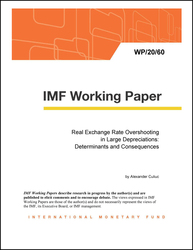
Real Exchange Rate Overshooting in Large Depreciations: Determinants and Consequences
Real Exchange Rate Overshooting in Large Depreciations: Determinants and Consequences
READ MORE...
Volume/Issue:
Volume 2020
Issue 060
Publication date: May 2020
ISBN: 9781513545226
$18.00
Add to Cart by clicking price of the language and format you'd like to purchase
Available Languages and Formats
| English |
Prices in red indicate formats that are not yet available but are forthcoming.
Topics covered in this book
This title contains information about the following subjects.
Click on a subject if you would like to see other titles with the same subjects.
Exports and Imports , Finance , Investments and Securities-General , WP , balance sheet effect , output loss , equilibrium depreciation , short-term debt , depreciation episode , expenditure switching effect , risk premium , debt intolerance , Depreciation , Financial statements , Currency mismatches , Exchange rates , Global , Exchange Rate , External Debt , Open Economy Growth
Summary
The consequences of large depreciations on economic activity depend on the relative strength of the contractionary balance sheet and expansionary expenditure switching effects. However, the two operate over different time horizons: the balance sheet effect hits almost immediately, while expenditure switching is delayed by nominal rigidities and other frictions. The paper hypothesizes that the overshooting phase—observed early in the depreciation episode and driven by the balance sheet effect—is largely irrelevant for expenditure switching, which is more closely aligned with ex-post equilibrium depreciation. Given this, larger real exchange rate overshooting should signal a relatively stronger balance sheet effect. Empirical findings support this hypothesis: (i) overshooting is driven by factors associated with the balance sheet effect (high external debt, low reserves, low trade openness), (ii) overshooting-based measures of the balance sheet effect foreshadow post-depreciation output losses, and (iii) the balance sheet effect is strongest early on, while expenditure switching strengthens over the medium term.
Copyright © 2010 - 2025
Powered by:
AIDC



